|
By Jenny Coyle
Walk This Way
 Some 6,000 children in Rhode Island got to school on foot when the Sierra Club's Rhode Island Chapter helped organize events to recognize International Walk to School Day on Oct. 2. "We built a coalition of 40 agencies to help with the event, so we had students, parents, teachers and community leaders all out there pounding the pavement," says Alicia Karpick, chapter director. Other activities included the singing of global warming Christmas carols, street theater and shoe decorating. The chapter organized the event in conjunction with its transportation reform campaign, which includes safe routes to school. Some 6,000 children in Rhode Island got to school on foot when the Sierra Club's Rhode Island Chapter helped organize events to recognize International Walk to School Day on Oct. 2. "We built a coalition of 40 agencies to help with the event, so we had students, parents, teachers and community leaders all out there pounding the pavement," says Alicia Karpick, chapter director. Other activities included the singing of global warming Christmas carols, street theater and shoe decorating. The chapter organized the event in conjunction with its transportation reform campaign, which includes safe routes to school.
Surviving the Weakest Link
It doesn't come in the course of a normal day for most Sierra Club members to drink a shotglass full of cow blood. But Linda Spencer of the Massachusetts Chapter did that recently, in Africa, to show her team spirit on "Survivor."
In her biography at www.cbs.com, Spencer - assistant director of career services at Harvard University in Boston - lists the Sierra Club among her extracurricular interests, along with mountain climbing, ice climbing, winter camping, international travel, in-line skating, spinning and yoga.
Unfortunately, she was voted off the show Nov. 1, so her "15 minutes of fame" was shorter than, say, Bobby Brady's.
Huh? Bobby Brady? Well, his real name is Mike Lookinland, and he recently made a very generous gift to The Sierra Club Foundation - his $10,000 earnings from his stint on "The Weakest Link."
Lookinland squared off against seven other former Brady Bunch cast members on NBC's game show in September, and while he wasn't the strongest link, his earnings will help protect air, water and wildlife.
Student Leaders Reap Fall Harvest in D.C.
 Rebecca Rosen, left, a Ridgewood High School (N.J.) senior and member of the Sierra Student Coalition's Conservation Committee, addressed Econference attendees at the Washington Monument at the end of a weekend conference. The Sierra Club and the Sierra Student Coalition were among 32 sponsors of the 2001 Econference, held at George Washington University, Oct. 19-21.
The weekend-long conference provided training, workshops and panels for student environmental leaders. Hundreds of students from more than 208 high schools and colleges in 44 states participated. Featured speakers included Carl Pope, executive director of the Sierra Club, and Myke Bybee, executive director of the Sierra Student Coalition. Rebecca Rosen, left, a Ridgewood High School (N.J.) senior and member of the Sierra Student Coalition's Conservation Committee, addressed Econference attendees at the Washington Monument at the end of a weekend conference. The Sierra Club and the Sierra Student Coalition were among 32 sponsors of the 2001 Econference, held at George Washington University, Oct. 19-21.
The weekend-long conference provided training, workshops and panels for student environmental leaders. Hundreds of students from more than 208 high schools and colleges in 44 states participated. Featured speakers included Carl Pope, executive director of the Sierra Club, and Myke Bybee, executive director of the Sierra Student Coalition.
Brains and Brawn
 Also contributing to the Sierra Club recently was Ken Midkiff, who easily survived riding his bicycle 100 miles in 90-degree heat on his 60th birthday, raising nearly $1,000 for the Missouri Chapter. He finished the stint sweaty, but not gasping for air. Also contributing to the Sierra Club recently was Ken Midkiff, who easily survived riding his bicycle 100 miles in 90-degree heat on his 60th birthday, raising nearly $1,000 for the Missouri Chapter. He finished the stint sweaty, but not gasping for air.
Midkiff served for eight years as Missouri Chapter director, and was recently promoted to director of the national Sierra Club's Clean Water Campaign. Which goes to show that he's recognized for his intellectual contributions to the Club as well.
On Midkiff's 56th birthday he rode 112 miles, and he plans to ride 70 miles on his 70th birthday.
Just so long as the money keeps rolling in, Ken.
Truly Green Lawns
Salmon in Washington waterways have a hard enough time surviving without having to deal with the weed killers, herbicides and fertilizers that wash off lawns and flow into local streams and wetlands.
The Snohomish Group of the Club's Cascade Chapter is giving the threatened fish a hand with a visible, inexpensive, grassroots educational effort that can be adopted by homeowners.
Members created signs for homeowners to post that say, "Salmon Friendly Lawn" - if the homeowner commits to limit yard watering and refrain from using toxic chemicals.
"We want them to understand that a clean-cut, manicured lawn isn't always the sign of a healthy lawn," group chair Phyllis Mains says in a newsletter article by media chair Michael Kundu. "In fact, it's usually the sign that this lawn is a source of salmon-destroying toxic run-off. We think these signs may help to change the collective neighborhood conscience."
The group cranked out 1,000 signs for a total of $350, and are still distributing them. Others interested in such a campaign may contact Mains at pmains@juno.com.
Don't Pick the Flowers
Two more species struggling to survive are the very rare Mt. Ashland lupine and Henderson's horkelia. The total population of Henderson's horkelia occupies fewer than 189 acres in southern Oregon and northern California.
"And the Mt. Ashland lupine is found in only one place - a 40-acre site on Oregon's Mt. Ashland," says John Sully, a botanist and executive committee member of the Oregon Chapter's Rogue Group. The single remaining stand of this lupine species is surrounded by roads, parking lots, radar equipment, buildings and the Mt. Ashland Ski Area.
Which is why the Rogue Group petitioned the U.S. Fish and Wildlife Service in August 1999 to list the flowers under the Endangered Species Act. Three months later, the agency said it had sufficient information to make a ruling, and regulations gave it one year to do so. But two years later, there is still no listing.
"Both plant species remain vulnerable to off-road vehicles, trespass grazing, a proposal to expand the ski area and other threats," says Rogue Group Chair Tom Dimitre. "We're concerned we'll soon see the decline - or extinction - of these rare plants." And so the Club has filed an intent to sue Fish and Wildlife over its failure to list the plants.
Looks like with the Sierra Club on their side, these species might have flower power.
'Dune Mother' Will Be Missed
The Santa Lucia Chapter in San Luis Obispo, Calif., is mourning the death - and celebrating the lifelong accomplishments - of powerhouse activist Kathleen Goddard Jones, who helped form that chapter.
She also was a founding member and first chair of the National Sierra Club Council of Chapters, and in 1993 she received a Special Achievement Award from the Club.
An avid supporter and protector of the fragile Guadalupe-Nipomo Dunes, she became known locally as "The Lady of the Dunes" and "Dune Mother."
Photo (top) courtesy Kate Canada
Up to Top
|